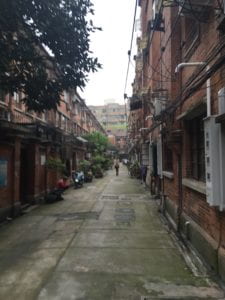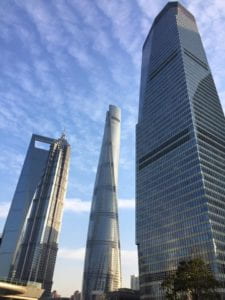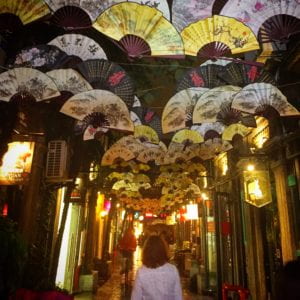Matthew Gibson
China Summer Fellow 2016
Shanghai, China
The French Concession is home to prominent Shanghai landmarks that earned the city it’s title of, “Paris of the East.” As you stroll along the narrow streets, you can imagine the splendor of this district of the city in it’s heyday in the 1950’s. But, today, the unique Art Deco style buildings are overshadowed by the sleek, modern high rises that dominate the city skyline. 
Fictional and nonfictional representations have given me a taste of the life of Shanghainese citizens and allowed me to imagine the city as it once was–to appreciate the importance of these buildings and this district at its point in time. But it can be hard to reconcile these two images of the city–one of luxury and character, and one of modernity and change. I felt that this tension was best captured at the entrance to a longtang that faced a small five avenue intersection.
The Shanghainese longtangs are isolated neighborhoods that are a very traditional form of architecture for this city. Encompassing entire city blocks, they are self enclosed communities where people’s lives are on display for near anyone who passes through the narrow streets. Across the street from the entrance to the traditional Shanghai alleyway style homes, stood a statue of an unknown Chinese historical figure, that stood out against a backdrop of brightly colored graffiti.
Today, the longtangs are facing extinction, as the city government works to demolish these aging structures to make room for new growth. Shanghai has grown faster in the last 30 years than anyone might have imagined, and the upsurge of both rural citizens and foreign investors puts more pressure on the seams of the city every day. In Pudong, buildings are built faster than they can be filled, and many of these staggering structures of glass and steel stand empty while peasant workers from rural provinces make camp around their base.
 But as you walk through the historic districts of Puxi, the few longtangs that remain are likely marked with a deep red “拆”–tear down. Hidden within them are residents of these homes who have never known a life outside of these stone walls. I recently heard the story of a man who’s family held onto their home through the turmoil of the Cultural Revolution and the Sino-Japanese War. Now, when faced with the destruction of his family’s legacy he believes his only remaining choice is to resolutely stay in his home, facing death if need be.
But as you walk through the historic districts of Puxi, the few longtangs that remain are likely marked with a deep red “拆”–tear down. Hidden within them are residents of these homes who have never known a life outside of these stone walls. I recently heard the story of a man who’s family held onto their home through the turmoil of the Cultural Revolution and the Sino-Japanese War. Now, when faced with the destruction of his family’s legacy he believes his only remaining choice is to resolutely stay in his home, facing death if need be.
My perception of this city is caught between these two images. I subconsciously succumb to the influence of Orientalism and expect that China should remain the provincial nation that dominates the Western imagination. Alternatively, I expect the infamous Shanghai to reflect the same growth and status that I experience in New York City. However, in reality, Shanghai is neither of those things. Shanghai has evolved from provincial society, perhaps in the same trajectory as that of major metropoles the likes of New York City, but in an entirely individual way. The result is a city enmeshed in the old and the new, changing before your eyes, but with lingering tradition and culture of the past if you still choose to look for it.

